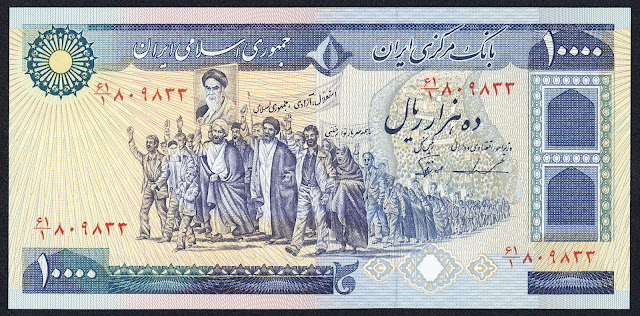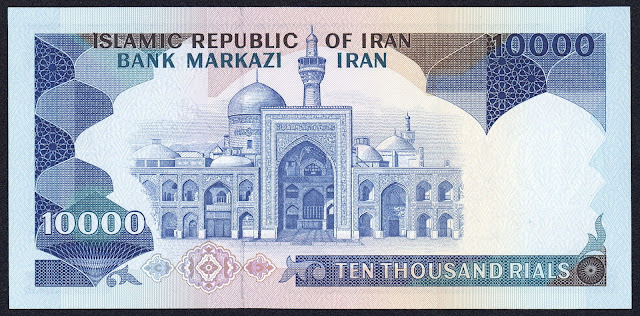Currency of Iran Currency 10000 Rials banknote 1981 Islamic Revolution
Banknotes of the Islamic Republic of Iran
Revolutionary Series 1981 - 2005
Revolutionary Series 1981 - 2005
Bank Markazi Iran - Central Bank of the Islamic Republic of Iran
Iranian banknotes, Iranian paper money, Iranian bank notes, Iran banknotes, Iran paper money, Iran bank notes.
Obverse: People Demonstration in Islamic Revolution Season - Mullahs leading marchers at center. Protesters carry a portraits of Ayatollah Ruhollah Khomeini during the 1979 revolution. Dark blue and green on yellow and multicolored underprint.
Signatures: Dr. Mohsen Noorbakhsh & Mohammad Djavad Iravani.
Reverse: The Holy Shrine of Imam Reza, Mashhad (the 8th Shiite Muslim leader) .
Signatures: Dr. Mohsen Noorbakhsh & Mohammad Djavad Iravani.
Reverse: The Holy Shrine of Imam Reza, Mashhad (the 8th Shiite Muslim leader) .
Watermark: The Allah emblem on all issues.
White security thread with BANK MARKAZI IRAN in black Persian script runs vertically.
Printer: Thomas De La Rue & Company, Limited. (without imprint).
Withdrawn from circulation: 22-09-2004
Exchangeable at CBI until: 21-09-2014
Banknotes of the Islamic Republic of Iran
Revolutionary Series 1981 - 2005
Iranian Revolution
The Iranian Revolution (also known as the Islamic Revolution or the 1979 Revolution) refers to events involving the overthrow of the Pahlavi dynasty under Mohammad Reza Shah Pahlavi, who was supported by the United States, and its eventual replacement with an Islamic Republic under the Grand Ayatollah Ruhollah Khomeini, the leader of the revolution, supported by various leftist and Islamist organizations and student movements.
Demonstrations against the Shah commenced in October 1977, developing into a campaign of civil resistance that included both secular and religious elements and which intensified in January 1978. Between August and December 1978 strikes and demonstrations paralyzed the country. The Shah left Iran for exile on 16 January 1979, as the last Persian monarch, leaving his duties to a regency council and an opposition-based prime minister. Ayatollah Khomeini was invited back to Iran by the government, and returned to Tehran to a greeting by several million Iranians. The royal reign collapsed shortly after on 11 February when guerrillas and rebel troops overwhelmed troops loyal to the Shah in armed street fighting, bringing Khomeini to official power. Iran voted by national referendum to become an Islamic Republic on 1 April 1979, and to approve a new theocratic-republican constitution whereby Khomeini became Supreme Leader of the country, in December 1979.
The revolution was unusual for the surprise it created throughout the world: it lacked many of the customary causes of revolution (defeat at war, a financial crisis, peasant rebellion, or disgruntled military), occurred in a nation that was enjoying relative prosperity, produced profound change at great speed, was massively popular, resulted in the exile of many Iranians, and replaced a pro-Western monarchy with an anti-Western authoritarian theocracy based on the concept of Guardianship of the Islamic Jurists (or velayat-e faqih). It was a relatively non-violent revolution, and helped to redefine the meaning and practice of modern revolutions (although there was violence in its aftermath).

